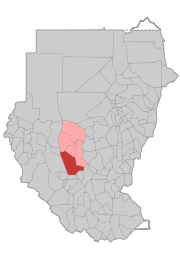
Abyei District
Encyclopedia

Districts of Sudan
The States of Sudan were subdivided into 133 districts. With the adoption of the Interim National Constitution of Sudan and the Interim Constitution of Southern Sudan , the ten states of South Sudan are however now divided into counties....
, considered part of the state of West Kurdufan
West Kurdufan
West Kurdufan was formerly one of the 26 wilayat or states of Sudan. It had an area of 111,373 km² and an estimated population of approximately 1,320,405...
. Upon the dissolution of West Kurdufan in 2005, it was included in the state of South Kurdufan
South Kurdufan
Southern Kordofan is one of the 15 wilayat or provinces of Sudan. It has an area of 158,355 km² and an estimated population of approximately 1,100,000 people . Kaduqli is the capital of the state...
. Its administrative centre was the town of Abyei
Abyei (town)
Abyei is a north-south border town currently in the Abyei Area of the South Kordofan region, in the south of Northern Sudan. The U.N...
Dissolution
The 2004 Protocol on the resolution of the Abyei conflict (Abyei Protocol) in the Comprehensive Peace AgreementComprehensive Peace Agreement
The Comprehensive Peace Agreement , also known as the Naivasha Agreement, was a set of agreements culminating in January 2005 that were signed between the Sudan People's Liberation Movement and the Government of Sudan...
(CPA) that ended the Second Sudanese Civil War
Second Sudanese Civil War
The Second Sudanese Civil War started in 1983, although it was largely a continuation of the First Sudanese Civil War of 1955 to 1972. Although it originated in southern Sudan, the civil war spread to the Nuba mountains and Blue Nile by the end of the 1980s....
included provisions to replace the Abyei district with a new jurisdiction to be accorded "special administrative status". The new area was to have different borders, intended to represent “the area of the nine Ngok Dinka
Dinka
The Dinka is an ethnic group inhabiting the Bahr el Ghazal region of the Nile basin, Jonglei and parts of southern Kordufan and Upper Nile regions. They are mainly agro-pastoral people, relying on cattle herding at riverside camps in the dry season and growing millet and other varieties of grains ...
chiefdoms transferred to Kordofan in 1905”, with demarcation to be determined by a multinational commission. After considerable dispute, a consensus on boundaries enclosing a territory considerably smaller than the existing Abyei district was reached in 2009. A new administration was established for the new Abyei Area
Abyei
The Abyei Area is an area of in Sudan accorded "special administrative status" by the 2004 Protocol on the resolution of the Abyei conflict in the Comprehensive Peace Agreement that ended the Second Sudanese Civil War. The capital of Abyei Area is Abyei Town...
, covering the southwestern part of the former district. It is unclear what local government provisions were put in place for the district's remaining territory.

